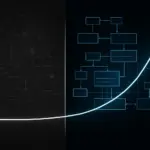Overcoming ‚Automation Blindness‘: How We Redesigned a Reporting Workflow to Spark Human Curiosity
For a few weeks, our Monday morning meetings felt strangely quiet. Our new, fully-automated marketing KPI dashboard—a project I’d been quite proud of—glowed on the screen. It was clean, efficient, and every key metric was green. Conversion rates were up, cost per acquisition was down. By all accounts, the system was a success.
But the silence was telling. There were no questions. No debates about why one channel was outperforming another. No curiosity. The team would simply nod, accept the green lights as confirmation that all was well, and move on.
We had inadvertently created a system so efficient at providing answers that it stopped anyone from asking questions. I call this phenomenon ‚Automation Blindness’—a state of passive acceptance where a team trusts the machine’s output so completely that they stop engaging in the very critical thinking the machine was meant to enable. The system was working, but our collective intelligence was shutting down.
The Illusion of Perfect Efficiency
Our initial goal was simple: eliminate the hours spent manually compiling data from various sources into a weekly report. We built a workflow that pulled data, calculated performance, and generated a pristine PDF. It was the picture of efficiency.
Yet, we had fallen into a classic pitfall. As research from Harvard Business Review highlights, when we automate tasks, the people responsible for them can lose the skills required to perform them—and more importantly, to scrutinize them. Our perfectly automated report had removed the need for the team to wrestle with the data. They no longer had to build the story from scratch each week, so they began to lose their intimate connection with the numbers.
The green indicators became a substitute for understanding. We had a dashboard full of answers and a room full of people who had forgotten the questions. This wasn’t just a reporting issue; it was a strategic one. If no one is questioning why things are going well, they certainly won’t be prepared to understand why they might go wrong.
The Automation Paradox in Practice
This experience was a perfect illustration of what MIT Sloan researchers call ‚The Automation Paradox.‘ In solving one problem (manual reporting), we had created a new, more insidious one: a decline in strategic inquiry. As automation handles routine tasks, the real value of human input shifts toward managing exceptions, interpreting complexity, and asking ‚what if.‘ Our system had automated the routine so well that it had eliminated the triggers for that deeper cognitive work.
This is a recurring theme I’ve observed in building systems that scale (URL: /building-systems-framework). The objective isn’t merely to automate tasks but to design a human-machine collaboration where technology handles the ‚what‘ and empowers people to explore the ‚why.‘ Our reporting system was failing on that second, more crucial, front. It was delivering information but stifling intelligence.
Re-Introducing ‚Cognitive Friction‘ into the System
We realized we didn’t need to dismantle the automation; we needed to change its output. The goal became to transform the report from a static declaration of facts into a dynamic catalyst for curiosity. We decided to introduce a bit of ‚cognitive friction’—subtle prompts designed to nudge the team to stop, think, and engage.
Here are the three key changes we made:
-
From Answers to Questions: The report no longer just stated a fact like, ‚Conversion Rate: 3.5% (Up 5% WoW).‘ The new system was programmed to add a provocative, open-ended question directly below the metric: ‚The 5% increase was our biggest jump this quarter. What campaign or factor do you believe was the primary driver?‘ The machine presented the data, but it tasked the humans with building the narrative.
-
Highlighting Anomalies, Not Just Goals: We reprogrammed the logic to flag not just negative deviations from our goals but also significant positive ones. An unexpected, massive spike in performance is just as important to understand as a sudden drop. It’s an opportunity to learn from and replicate. The report now highlighted these outliers, forcing a discussion about opportunity, not just problems.
-
Providing Contextual Benchmarks: A single number is meaningless without context. Instead of just showing our current CPA, the report now automatically included the 3-month average, the CPA for our top-performing channel, and an anonymized industry benchmark where available. This gave the team multiple reference points, turning a simple metric into a rich point for discussion about relative performance.
These weren’t massive technical overhauls. They were small, thoughtful adjustments to the system’s output, designed to shift the user’s role from passive consumer to active investigator.
The Cultural Shift: From Reporting to Reflecting
The impact was immediate. The Monday meetings transformed. The report on the screen was no longer the end of the conversation; it was the beginning. The team came prepared with hypotheses for the system’s questions. They debated the drivers behind anomalies and started using the benchmarks to set more intelligent goals.
This aligns with McKinsey’s findings on human-centric automation: the most successful systems are those that empower frontline workers and create a culture of continuous improvement. By reintroducing cognitive friction, we were using automation to foster that very culture. It’s a principle we also apply to our marketing automation system (URL: /marketing-automation-experiments) at Mehrklicks, where the goal is to use data to understand user intent, not just trigger automated sequences.
The dashboard became a tool for thought, not a substitute for it. The silence was replaced by productive, data-driven debate. We were no longer just reporting on the past; we were actively shaping the future, all because we asked our automated system to be a little less certain and a lot more curious.
Frequently Asked Questions about Automation and Team Culture
What is ‚automation blindness‘?
Automation blindness is a state where teams become so reliant on an automated system’s outputs, like reports or alerts, that they stop critically evaluating the data or the processes behind it. They trust the system’s ‚green lights‘ without question, which stifles curiosity, strategic thinking, and the ability to spot underlying issues or opportunities.
Isn’t the goal of automation to reduce human work?
Yes, but it’s crucial to distinguish between tedious work and cognitive work. The goal is to automate repetitive, low-value tasks (like data compilation) to free up human capacity for high-value cognitive work: strategy, interpretation, and problem-solving. Great automation doesn’t replace thinking; it augments it by providing better tools and starting points.
How do you start implementing these kinds of changes?
Start small. Pick one automated report or dashboard your team uses. Add a single, open-ended question below a key metric that will be discussed in your next meeting. For example, instead of just showing ‚Website Traffic,‘ add ‚Which content piece or channel drove the most engaged traffic this week?‘ The goal is to pilot the idea of using reports to prompt discussion rather than just present facts.
Does this apply to more than just reporting?
Absolutely. This principle of human-centric automation applies across business functions. In manufacturing, it might mean using sensors to flag subtle performance deviations that require an engineer’s diagnostic expertise. In project management, it could be a system that highlights potential resource conflicts for a manager to resolve creatively. It’s a core concept when leveraging AI for operational efficiency (URL: /leveraging-ai-in-operations)—the technology should always serve to elevate, not eliminate, human expertise.
Next Steps: Building a Curious System
This project was a reminder that the most effective systems are rarely the most frictionless ones. True scalability comes from a partnership between human intelligence and machine efficiency.
Take a look at one of your own automated reports this week. Is it ending a conversation or starting one? Is it providing certainty or provoking curiosity? The best systems don’t just give you the answers; they help you ask better questions.




